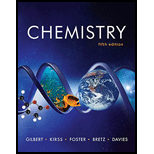
Chemistry: The Science in Context (Fifth Edition)
5th Edition
ISBN: 9780393615142
Author: Stacey Lowery Bretz, Geoffrey Davies, Natalie Foster, Thomas R. Gilbert, Rein V. Kirss
Publisher: W. W. Norton & Company
expand_more
expand_more
format_list_bulleted
Question
Chapter 9, Problem 9.111QP
Interpretation Introduction
Interpretation: The bond length of
Concept introduction: The bond length is the distance between the nuclei of two bonded atoms. The bond length is in inverse proportion with the number of bonded electrons higher the number of bonded electrons shorter would be the bond length.
To determine: The bond lengths of
Expert Solution & Answer
Want to see the full answer?
Check out a sample textbook solution
Chapter 9 Solutions
Chemistry: The Science in Context (Fifth Edition)
Ch. 9.2 - Prob. 1PECh. 9.2 - Prob. 2PECh. 9.2 - Prob. 3PECh. 9.3 - Prob. 4PECh. 9.4 - Prob. 5PECh. 9.4 - Prob. 6PECh. 9.4 - Prob. 7PECh. 9.5 - Prob. 8PECh. 9.5 - Prob. 9PECh. 9.7 - Prob. 10PE
Ch. 9.7 - Prob. 11PECh. 9.7 - Prob. 12PECh. 9.7 - Prob. 13PECh. 9 - Prob. 9.1VPCh. 9 - Prob. 9.2VPCh. 9 - Prob. 9.3VPCh. 9 - Prob. 9.4VPCh. 9 - Prob. 9.5VPCh. 9 - Prob. 9.6VPCh. 9 - Prob. 9.7VPCh. 9 - Prob. 9.8VPCh. 9 - Prob. 9.9QPCh. 9 - Prob. 9.10QPCh. 9 - Prob. 9.11QPCh. 9 - Prob. 9.12QPCh. 9 - Prob. 9.13QPCh. 9 - Prob. 9.14QPCh. 9 - Prob. 9.15QPCh. 9 - Prob. 9.16QPCh. 9 - Prob. 9.17QPCh. 9 - Prob. 9.18QPCh. 9 - Prob. 9.19QPCh. 9 - Prob. 9.20QPCh. 9 - Prob. 9.21QPCh. 9 - Prob. 9.22QPCh. 9 - Prob. 9.23QPCh. 9 - Prob. 9.24QPCh. 9 - Prob. 9.25QPCh. 9 - Prob. 9.26QPCh. 9 - Prob. 9.27QPCh. 9 - Prob. 9.28QPCh. 9 - Prob. 9.29QPCh. 9 - Prob. 9.30QPCh. 9 - Prob. 9.31QPCh. 9 - Prob. 9.32QPCh. 9 - Prob. 9.33QPCh. 9 - Prob. 9.34QPCh. 9 - Prob. 9.35QPCh. 9 - Prob. 9.36QPCh. 9 - Prob. 9.37QPCh. 9 - Prob. 9.38QPCh. 9 - Prob. 9.39QPCh. 9 - Prob. 9.40QPCh. 9 - Prob. 9.41QPCh. 9 - Prob. 9.42QPCh. 9 - Prob. 9.43QPCh. 9 - Prob. 9.44QPCh. 9 - Prob. 9.45QPCh. 9 - Prob. 9.46QPCh. 9 - Prob. 9.47QPCh. 9 - Prob. 9.48QPCh. 9 - Prob. 9.49QPCh. 9 - Prob. 9.50QPCh. 9 - Prob. 9.51QPCh. 9 - Prob. 9.52QPCh. 9 - Prob. 9.53QPCh. 9 - Prob. 9.54QPCh. 9 - Prob. 9.55QPCh. 9 - Prob. 9.56QPCh. 9 - Prob. 9.57QPCh. 9 - Prob. 9.58QPCh. 9 - Prob. 9.59QPCh. 9 - Prob. 9.60QPCh. 9 - Prob. 9.61QPCh. 9 - Prob. 9.62QPCh. 9 - Prob. 9.63QPCh. 9 - Prob. 9.64QPCh. 9 - Prob. 9.65QPCh. 9 - Prob. 9.66QPCh. 9 - Prob. 9.67QPCh. 9 - Prob. 9.68QPCh. 9 - Prob. 9.69QPCh. 9 - Prob. 9.70QPCh. 9 - Prob. 9.71QPCh. 9 - Prob. 9.72QPCh. 9 - Prob. 9.73QPCh. 9 - Prob. 9.74QPCh. 9 - Prob. 9.75QPCh. 9 - Prob. 9.76QPCh. 9 - Prob. 9.77QPCh. 9 - Prob. 9.78QPCh. 9 - Prob. 9.79QPCh. 9 - Prob. 9.80QPCh. 9 - Prob. 9.81QPCh. 9 - Prob. 9.82QPCh. 9 - Prob. 9.83QPCh. 9 - Prob. 9.84QPCh. 9 - Prob. 9.85QPCh. 9 - Prob. 9.86QPCh. 9 - Prob. 9.87QPCh. 9 - Prob. 9.88QPCh. 9 - Prob. 9.89QPCh. 9 - Prob. 9.90QPCh. 9 - Prob. 9.91QPCh. 9 - Prob. 9.92QPCh. 9 - Prob. 9.93QPCh. 9 - Prob. 9.94QPCh. 9 - Prob. 9.95QPCh. 9 - Prob. 9.96QPCh. 9 - Prob. 9.97QPCh. 9 - Prob. 9.98QPCh. 9 - Prob. 9.99QPCh. 9 - Prob. 9.100QPCh. 9 - Prob. 9.101QPCh. 9 - Prob. 9.102QPCh. 9 - Prob. 9.103QPCh. 9 - Prob. 9.104QPCh. 9 - Prob. 9.105QPCh. 9 - Prob. 9.106QPCh. 9 - Prob. 9.107QPCh. 9 - Prob. 9.108QPCh. 9 - Prob. 9.109QPCh. 9 - Prob. 9.110QPCh. 9 - Prob. 9.111QPCh. 9 - Prob. 9.112QPCh. 9 - Prob. 9.113QPCh. 9 - Prob. 9.114QPCh. 9 - Prob. 9.115APCh. 9 - Prob. 9.116APCh. 9 - Prob. 9.117APCh. 9 - Prob. 9.118APCh. 9 - Prob. 9.119APCh. 9 - Prob. 9.120APCh. 9 - Prob. 9.121APCh. 9 - Prob. 9.122APCh. 9 - Prob. 9.123APCh. 9 - Prob. 9.124APCh. 9 - Prob. 9.125APCh. 9 - Prob. 9.126APCh. 9 - Prob. 9.127APCh. 9 - Prob. 9.128APCh. 9 - Prob. 9.129APCh. 9 - Prob. 9.130APCh. 9 - Prob. 9.131APCh. 9 - Prob. 9.132APCh. 9 - Prob. 9.133APCh. 9 - Prob. 9.134APCh. 9 - Prob. 9.135APCh. 9 - Prob. 9.136APCh. 9 - Prob. 9.137APCh. 9 - Prob. 9.138APCh. 9 - Prob. 9.139APCh. 9 - Prob. 9.140APCh. 9 - Prob. 9.141APCh. 9 - Prob. 9.142APCh. 9 - Prob. 9.143AP
Knowledge Booster
Learn more about
Need a deep-dive on the concept behind this application? Look no further. Learn more about this topic, chemistry and related others by exploring similar questions and additional content below.Linear Combination of Atomic Orbitals LCAO; Author: Edmerls;https://www.youtube.com/watch?v=nq1zwrAIr4c;License: Standard YouTube License, CC-BY
Quantum Molecular Orbital Theory (PChem Lecture: LCAO and gerade ungerade orbitals); Author: Prof Melko;https://www.youtube.com/watch?v=l59CGEstSGU;License: Standard YouTube License, CC-BY